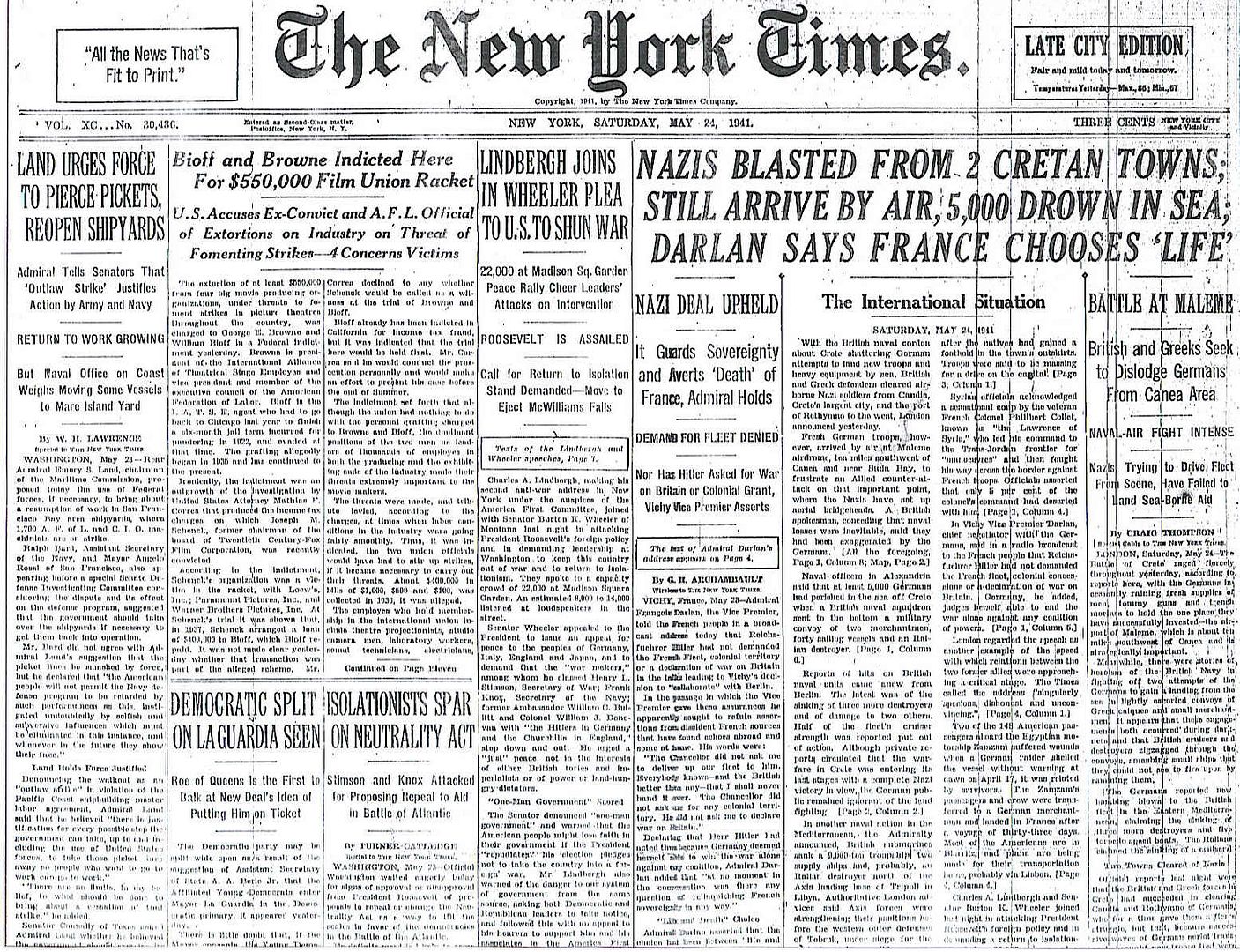
Posted on 05/24/2011 5:16:18 AM PDT by Homer_J_Simpson

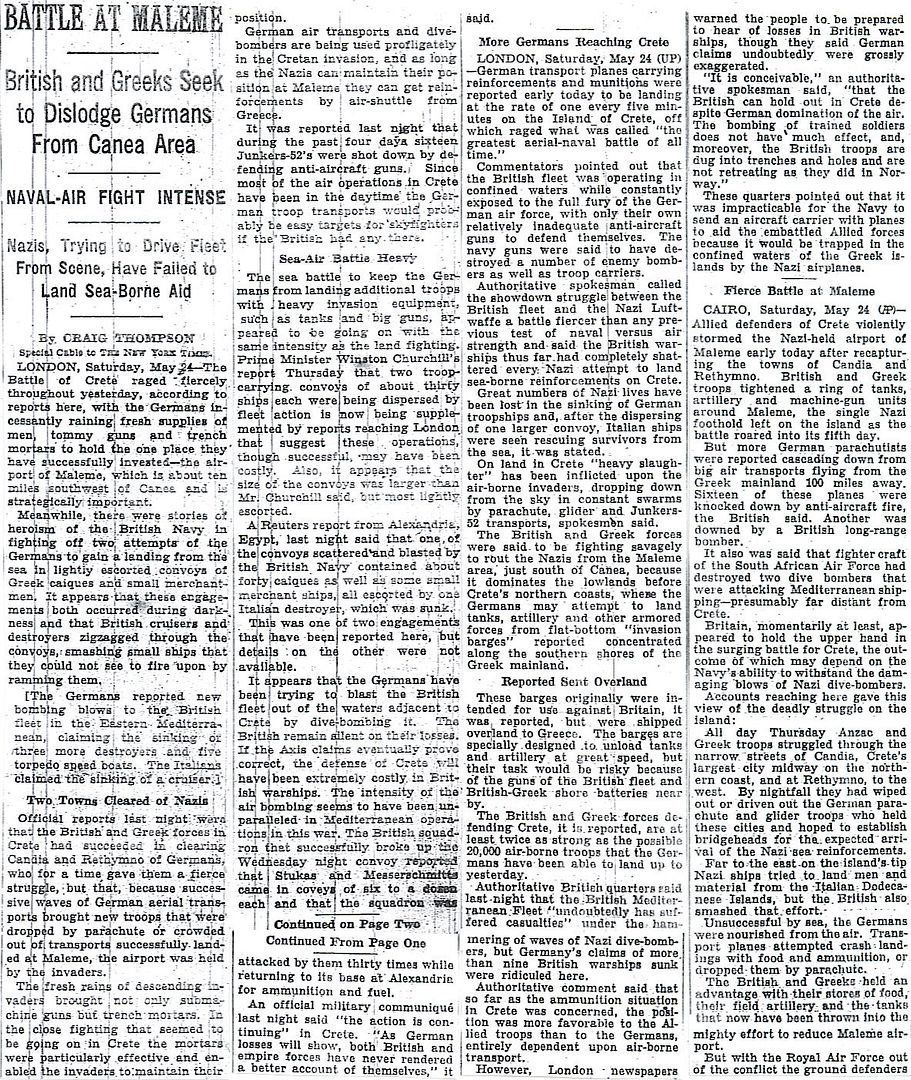
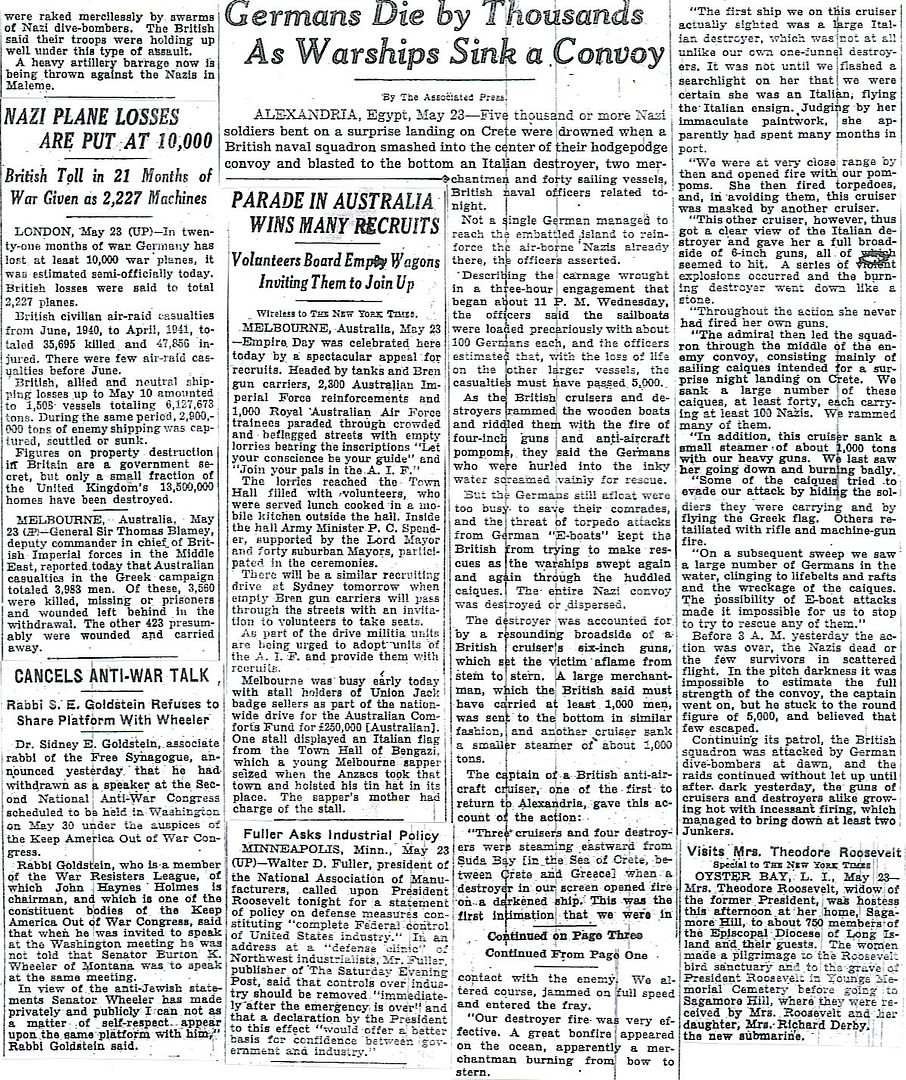
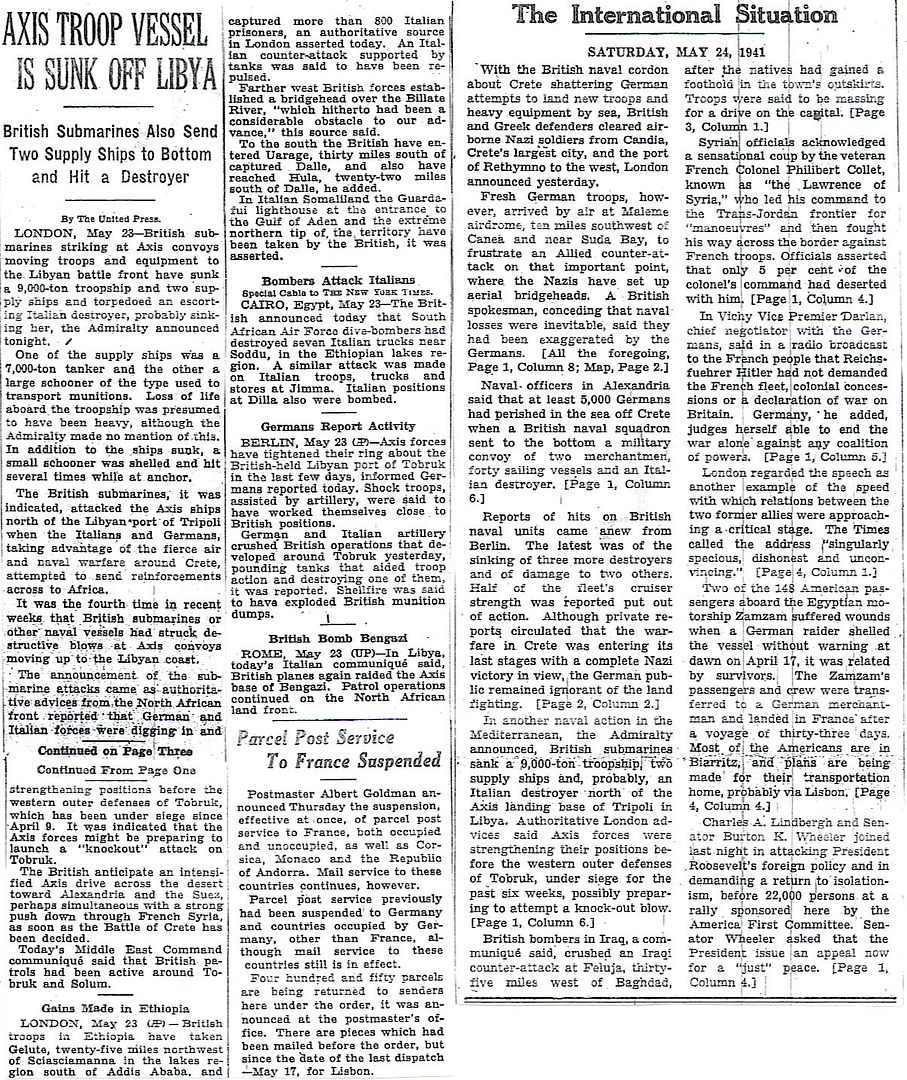
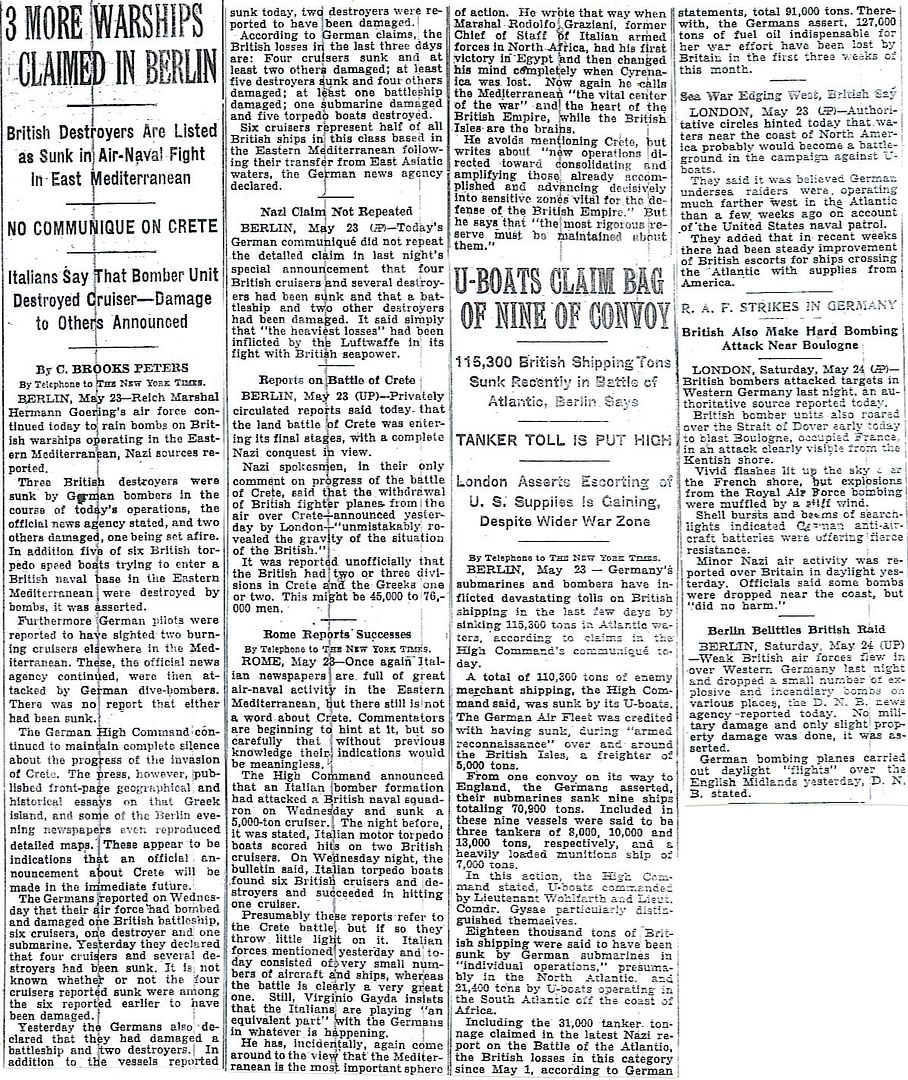
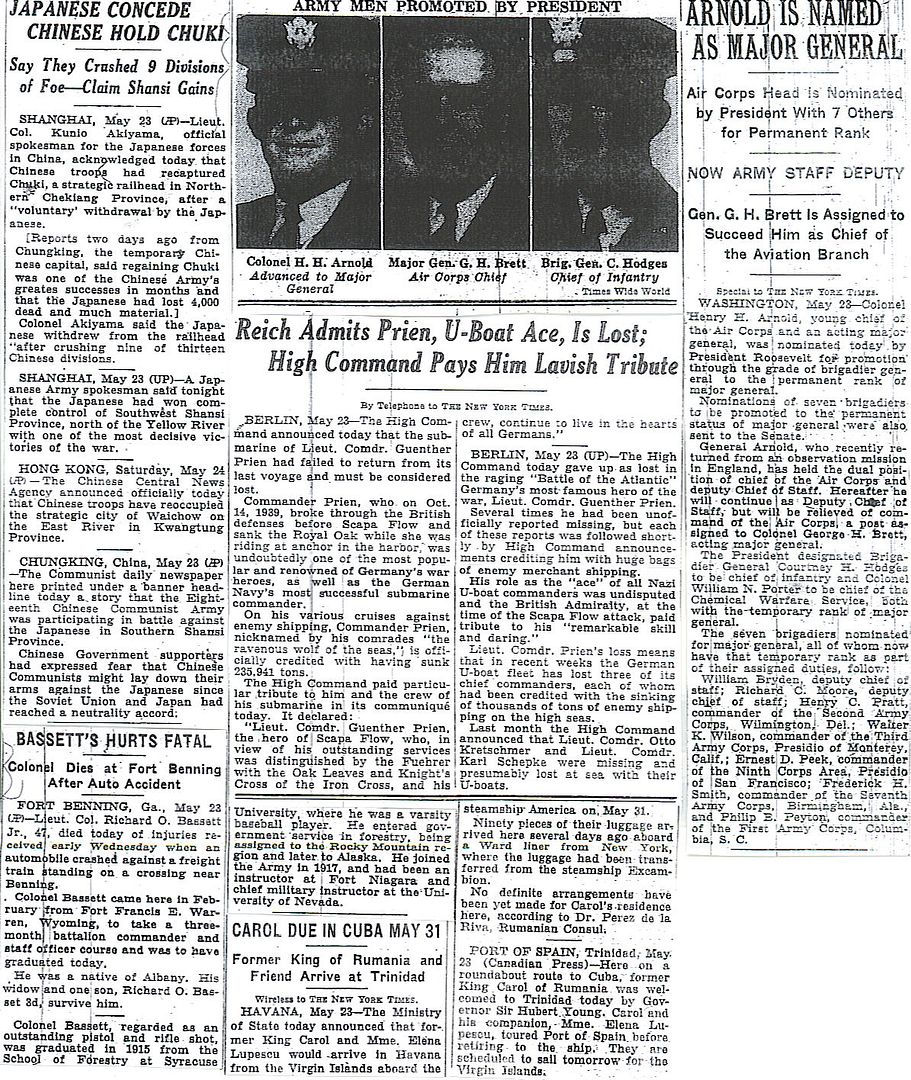
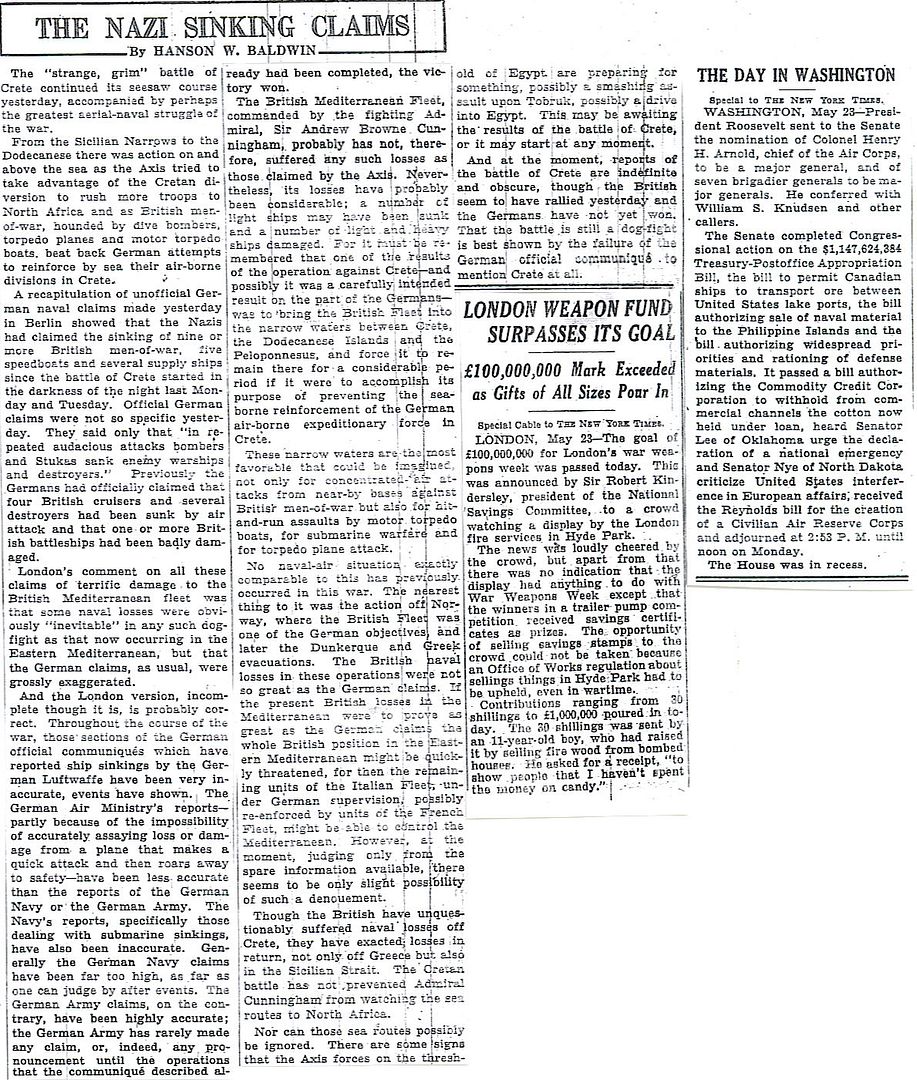
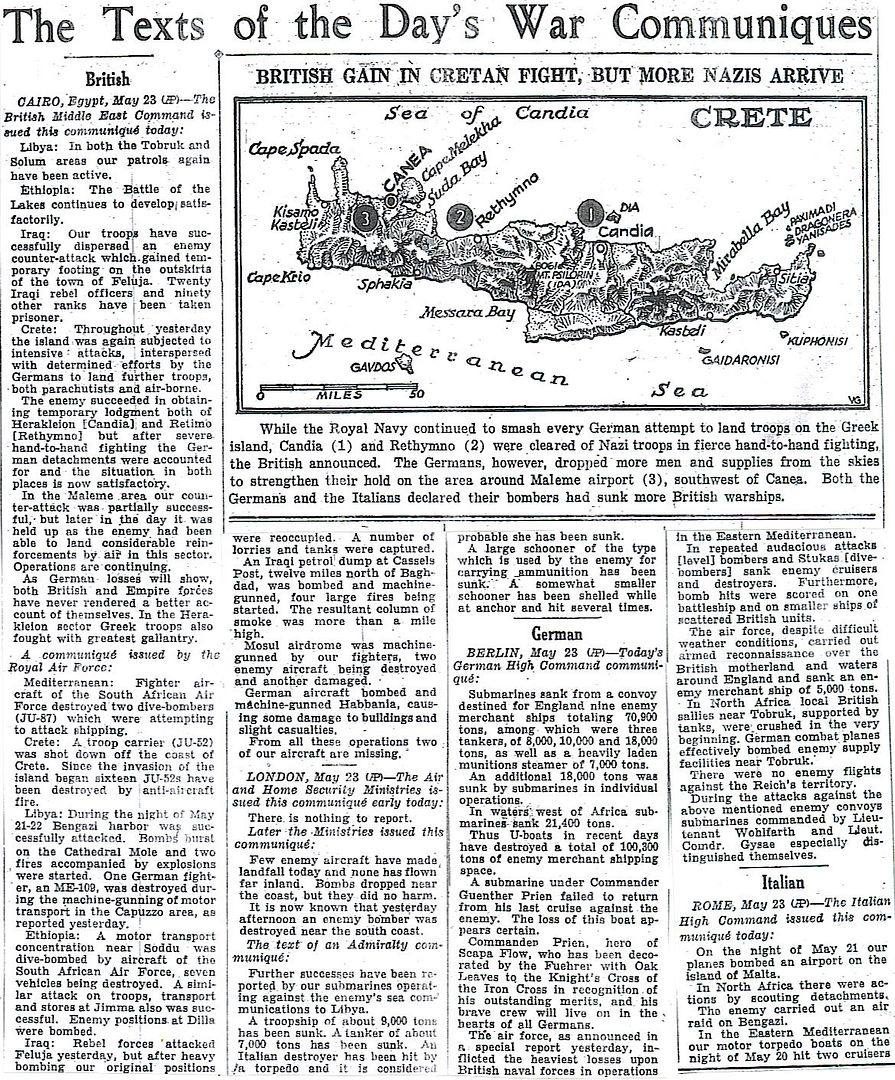
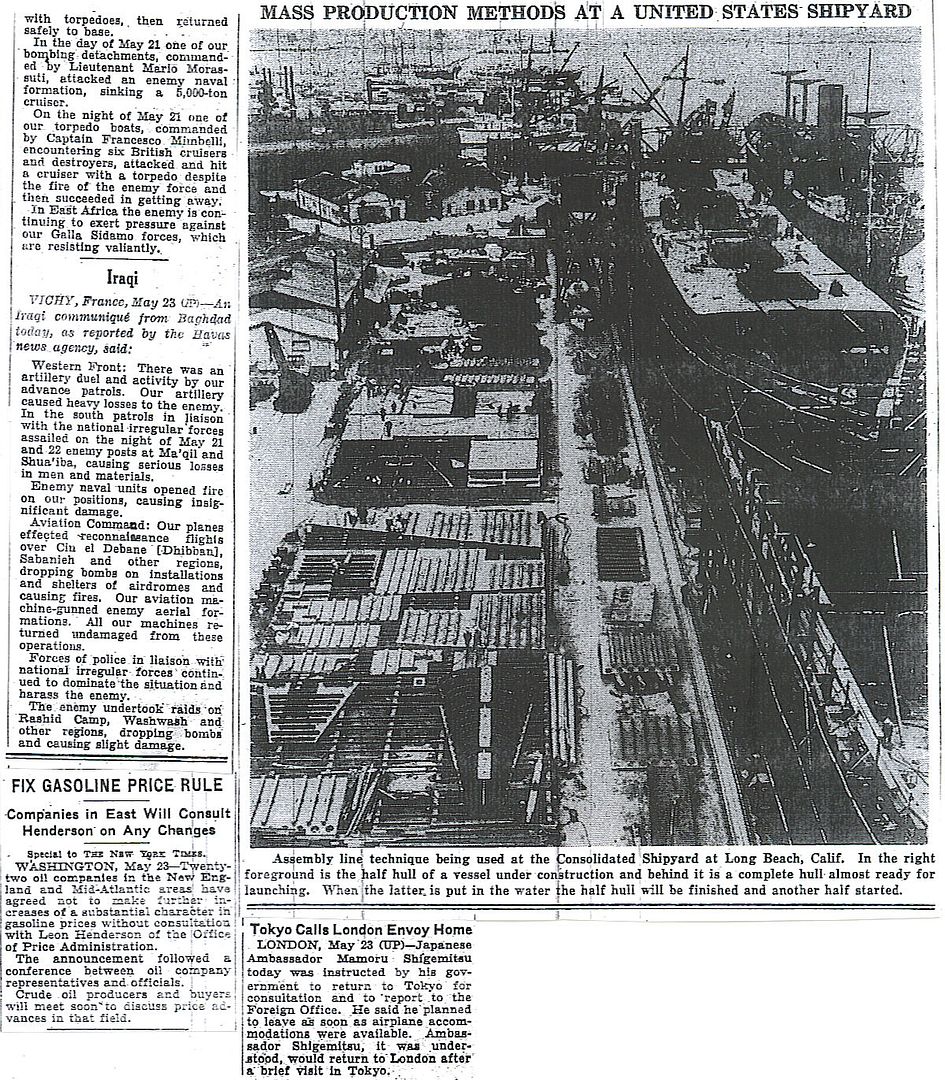
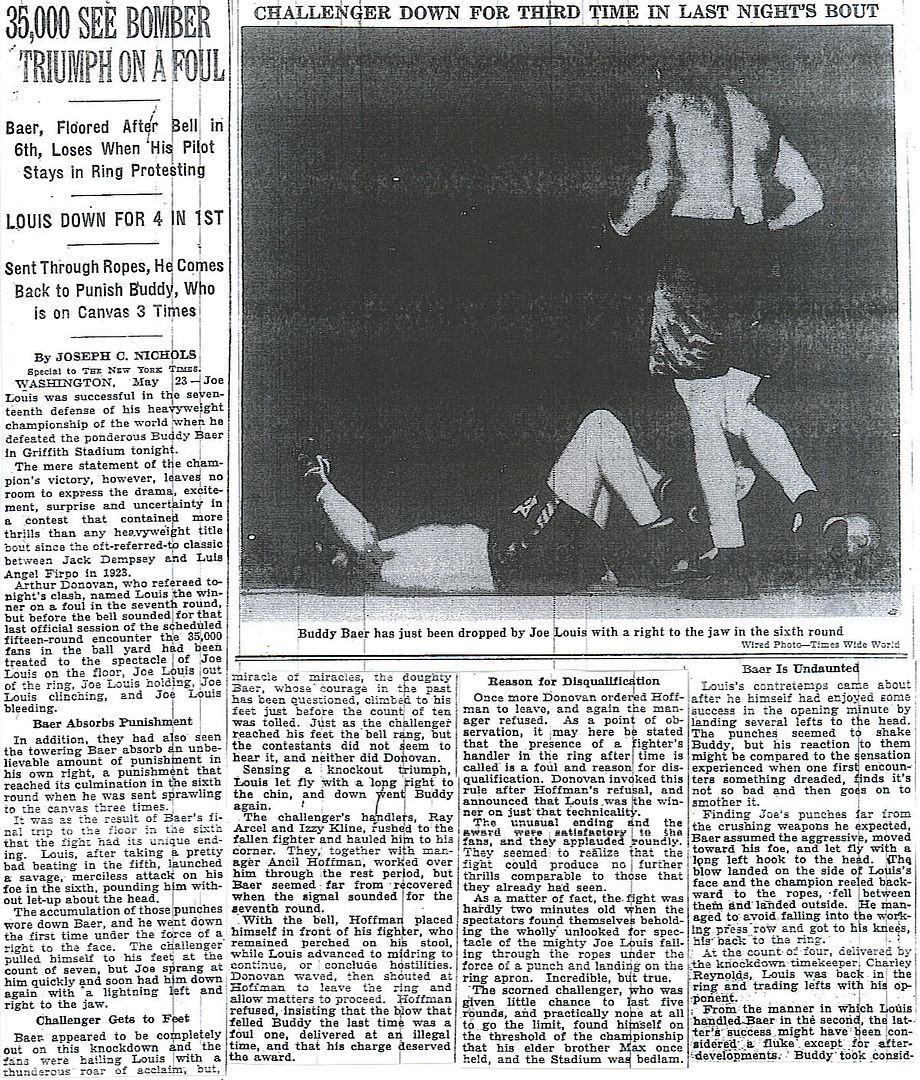
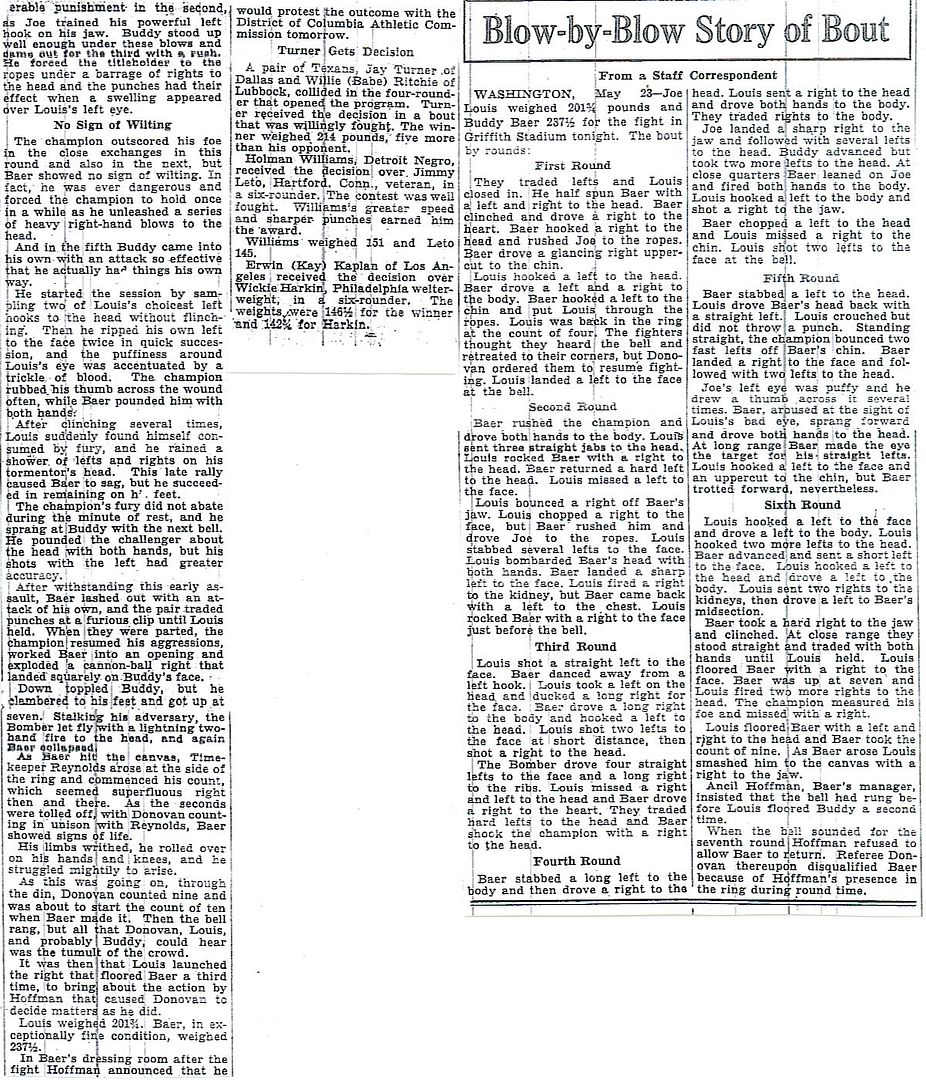
#1 – “Amapola” ((Pretty Little Poppy) - Jimmy Dorsey, with Bob Eberly and Helen O’Connell
#2 - “G’Bye Now” – Horace Heidt, with Ronnie Kemper
#3 - “My Sister And I” - Jimmy Dorsey, with Bob Eberly
#4 - “Dolores” – Bing Crosby and the Merry Macs
#5 - “I’ll Be With You in Apple Blossom Time” – The Andrews Sisters
#6 - “The Band Played On” - Guy Lombardo, with the Kenny Gardner Trio
#7 – “Green Eyes” - Jimmy Dorsey, with Bob Eberly and Helen O’Connell
#8 - “Intermezzo” – Wayne King
#9 - “Maria Elena” - Jimmy Dorsey, with Bob Eberly
#10 – “Until Tomorrow” – Sammy Kaye and the Kaydets
Sports
35,000 See Bomber Triumph on a Foul – 10-11
Blow-by-Blow Story of Bout - 11
Headlines from the day sure show what traitors union members were(and still are). Putting their wages ahead of the security of the country.
http://www.onwar.com/chrono/1941/may41/f24may41.htm
HMS Hood blows up
Saturday, May 24, 1941 www.onwar.com
In the North Atlantic... The Hood and the Prince of Wales come up and engage the Bismark and Prinz Eugen. The Hood is sunk very quickly. Only three men of the Hood’s complement of 1416 are saved. A short while later the Prince of Wales breaks off the action after receiving some damage. After the action the British cruisers continue to shadow the German ships. The Bismark has been hit three times, which has caused the loss of some fuel and the contamination of more. Admiral Lutjens therefore decides to put in to Brest. The British battleships Rodney and Ramillies leave the convoys they have been escorting to join the hunt. Force H, with the battle cruiser Renown and the carrier Ark Royal, puts to sea from Gibraltar. During the night of the May 24-25th aircraft from the Home Fleet carrier Victorious attack, and hit the Bismark with one torpedo. The damage is negligible. Later in the night Prinz Eugen slips away to operate independently, and later still contact is lost between the shadowing British cruisers and the Bismark.
In the Mediterranean... On Crete, the Allied forces in the Canea area are not in positions around Galatas. The German buildup at Maleme continues.
In East Africa... In southern Abyssinia Soddu falls to the Allied forces. In this area General Gazzera leads seven weak Italian divisions. The attacking Allied force is made up of the 11th and 12th African Divisions.
To the Times, we’re all Cretans
http://www.kbismarck.com/histoperi.html
24 May 1941 (Saturday):
0543. Course 220º. Speed 28 knots. Bismarck and Prinz Eugen sight two ships at 17 miles on port side.
0552. Hood opens fire and the Battle of the Denmark Strait begins. Bismarck reports to Group North: “Am in a fight with two heavy units.”
0555. Bismarck fires her first salvo at Hood followed shortly after by Prinz Eugen.
0555-0601. Bismarck is hit on the port side by three 35.6cm shells from Prince of Wales. One amidships under the armoured belt (section XIV), a second in her bows (section XXI), and the third one passes through a boat.
0601. Hood blows up and sinks in approximate position 63º 22’ North, 32º 17’ West.
0602-0609. Bismarck scores four hits on Prince of Wales.
0609. Fires last salvo at Prince of Wales. 93 x 38cm armour piercing shells (Psgr. L/4,4 (m.Hb)) fired. She is losing oil and her top speed is reduced to 28 knots. 1,000 tons of water in the forecastle.
0632. Bismarck reports to Group North: “Battlecruiser, probably Hood, sunk. Another battleship, King George or Renown, damaged. Two heavy cruisers keep up surveillance.”
0705. Bismarck reports to Group North: “We have sunk a battleship at about 63º 10’ North, 32º 00’ West.”
0801. Bismarck reports to Group North:
1. Loss of Electric plant No. 4.
2. Port Boiler Room No. 2 is taking water, but can be held. Water in forecastle.
3. Maximum speed 28 knots.
4. Denmark Strait 50 miles of floating mines. Enemy has radar instruments.
5. Intention: to put to St. Nazaire. No losses of personnel.
1200. Position 60º 50’ North, 37º 50’ West.
1240. New course 180º. Speed 24 knots.
1814. Turns 180º to starboard while the Prinz Eugen leaves the formation.
1840-1856. Fires some shells at Suffolk and Prince of Wales. No hits.
1914. Bismarck reports to Seekriegsleitung: “Brief fight with King George without results. Prinz Eugen released for oiling. Opponent keeps up surveillance.”
2056. Bismarck reports to Group West and Seekriegsleitung: “Shaking off contacts impossible due to enemy radar. Due to fuel [shortage] will proceed directly to Saint-Nazaire.”
2300. Sighted by the United States Coast Guard Cutter Modoc.
Midnight. Bismarck is attacked by eight Swordfish of the 825th Squadron (Lieutenant-Commander (A) Eugene Esmonde) from carrier Victorious. Bismarck’s speed 27 knots. The battleship is hit by one 18 inch MK XII torpedo on the starboard side, amidships. The damage is insignificant, but the shock of the impact causes one casualty aboard: Oberbootsmann Kurt Kirchberg.
http://www.hmshood.com/history/timeline4.htm
24 May: Hood sunk in the Battle of the Denmark Strait. In the engagement, Hood, Prince of Wales and Bismarck all received damage. At 0600, Hood sank following a catastrophic conflagration/explosion most likely resulting from a deep penetrating hit from Bismarck. Out of a crew of 1,418 only three (Ordinary Signalman Ted Briggs, Midshipman William Dundas and Able Seaman Robert Tilburn) survived. Despite the loss of Hood, the action DID achieve the result of effectively cancelling the German sortie: Though Prinz Eugen escaped, Bismarck was later defeated and sunk with a heavy loss of life. No convoys were lost to either ship.
http://homepage.ntlworld.com/andrew.etherington/month/thismonth/24.htm
May 24th, 1941
UNITED KINGDOM: A “MOST SECRET” British document lists how the Irish have cooperated with the British by:
1. Giving them a large amount of detailed information about roads, railways and military facilities in Eire in the event of a German invasion.
2. Whenever a German aircraft or submarine was sighted in or over Irish territory, the Irish would broadcast the location of the intruder “in the clear” on radio frequencies the British monitored.
3. Allowed the RAF to fly over certain specified areas.
4. Did not protest overflights by RAF aircraft over the rest of the country.
5. Provided daily intelligence information to Britain.
6. Allowed the British Legation to keep two secret transmitters and a private telephone line to London and Belfast.
7. Routed all German and Italian official communications through Britain.
8. Allowed the British to install equipment that resulted in the decreased efficiency of the RTE, the Irish national radio service, so the Germans could not use it as a guide for bombing the UK.
9. Transferred seven Irish tankers to Britain.
10. Allied airmen who went down in Eire were quietly taken to the border and turned over to Allied officers in Ulster.
11. All German spies and military personnel who were captured were interned for the duration of the war. (Jack McKillop)
GERMANY: Daily Keynote from the Reich Press Chief:
The special announcement about Crete should form your front-page story. Germany’s is one of the boldest military strokes in world history and awakens the pride of the nation. It should be an occasion for emphatic political commentary. Above all, emphasize the contrast between Churchill’s initial boastful remarks and the German reporting that began only when factual battle results could be truthfully reported.
U-446 laid down.
U-505, U-702 launched.
U-433, U-752 commissioned. (Dave Shirlaw)
FINLAND: Finnish military delegation, headed by Lt. Gen. Erik Heinrichs, travels to Germany. In the next two days they’re engaged in negotiations with generals Jodl and Halder about the Finnish military dispositions in the event of a Russo-German war. While the Finns are not empowered to make any binding promises, it is understood that Finland shall prepare to go to war against Soviet Union.
Since the end of the Winter War in March 1940, Finland had looked for an opportunity to seek redress for one way or another. Initially it was feared that Soviets will attack at the first opportunity to finish conquering Finland, and especially in the summer and autumn of 1940 the situation looked very threatening. The Soviet diplomats began forcing issues by threats, and it looked like all the Soviets were looking for was an excuse. The Finnish intelligence detected Soviet troop movements near the border. But the invasion never came. It is possible that Stalin was waiting for the Germans to provide a diversion to draw world’s attention away from Finland, namely in the form of a German invasion of Britain. It can perhaps be said that by defeating the Luftwaffe in the Battle of Britain, the RAF also saved the Finnish independence.
During the Winter War Germany had been very cool towards Finland, respecting the pact it had with Stalin. But in late 1940 the attitude began to change. Hitler had decided to go to war with the Soviet Union, and the Finns were in that case valuable allies. Germany began to sell arms to Finland, and soon began dropping hints about a possible change in the Russo-German relations. In the spring of 1941 the Fenno-German co-operation had become quite concrete, and German troops were streaming into northern Finland.
Around that time, in late spring 1941, Stalin’s attitude towards Finland began to change. Threats were forgotten, and the Soviet Union became very accommodating in all deals. But by now it was already too late. Stalins actions had driven Finland firmly in the German camp. (Mikko Härmeinen)
GREECE: CRETE: The Allies are pushed back to Galatas as German forces build-up around Maleme. During the night Ramcke’s forces break though to Oberst Heidrich at Galatos. The New Zealand defence line is smashed by Stuka dive bombers and the way to Chania is open.
MEDITERRANEAN SEA: Lt-Cdr Malcolm David Wanklyn (1911-42) of HMS Upholder sank a troopship and survived 37 enemy depth charges in 20 minutes. South of Sicily, the submarine managed at immense risk to penetrate a heavily escorted Axis convoy and sink a large troopship - the 18,000 ton liner Conte Rosso - bound for North Africa. The attack was made even more difficult by a defect with the submarine’s listening gear, forcing her to remain at periscope depth for the entire penetration of the convoy. Upholder then had to endure heavy depth charge retaliation from the escorts, but survived to sink some 100,000 tons of shipping before being lost the following year. Wanklyn received the Victoria Cross. (Dave Shirlaw)
ETHIOPIA: Soddu falls to the Allies.
CANADA: Corvettes HMCS Matapedia, Barrie and Dauphin arrived Halifax from builders. (Dave Shirlaw)
U.S.A.: The U.S. Congress passes a bill authorizing the construction or acquisition of 550,000 tons of auxiliary vessels for use by the U.S. Navy. (Jack McKillop)
ATLANTIC OCEAN: The BISMARK joins battle; HMS Hood is destroyed and HMS Prince of Wales is forced to veer off after being badly hit.
Around 06.00 after firing two or three salvoes, BISMARK hits HMS Hood in her main magazine which blows up with only three survivors (picked up by the destroyer HMS Electra (Rich Pelvin)) and 1418 casualties. She sinks at 63 20N, 31 50W. Now it is HMS Prince of Wales turn to be the target. After being hit several times she turns away but not before damaging BISMARK and causing her to lose fuel oil to the sea. German Admiral Lutjens then decides to make for St. Nazaire in France and heads southwest and later south out of the Denmark Strait. The two RN cruisers, and for a while the damaged Prince of Wales, continue to shadow. Admiral Tovey hurries west with the rest of Home Fleet.
Fifteen Swordfish are armed with torpedoes and sent to delay the ship. HMS Sheffield is between Ark Royal and Bismark. The aircraft falsely identified the British cruiser as their target and fire torpedoes. The torpedoes are fitted with unreliable magnetic detonators, which cause most to explode on contact with the water, while Sheffield evaded the rest. After realising his mistake, one of the pilots signalled ‘Sorry for the Kipper’ to Sheffield.
On return to the carrier, the Swordfishes are re-armed with contact-detonator warheads and launched at 19.15 hours for a second attack; locating and attacking Bismark just before sunset. Three torpedoes hit the battleship: two impacted forward of the engine rooms, while the third struck the port steering room and jams the rudder in a 15º port turn. Bismark is forced to sail in circles until the disabled rudder is reset to neutral, at which point she was sailing towards the British warships with almost no manoeuvring capability.
With Hood’s loss, Force H (Admiral Somerville) with battlecruiser HMS Renown, carrier Ark Royal and cruiser HMS Sheffield is sailing north from Gibraltar. Battleship Ramillies, released from convoy escort duties, and Rodney, then to the west of Ireland, head towards BISMARK’s expected track. Ramillies does not play a part in later operations.
At 18.00 BISMARK feints north towards her shadowers long enough to allow Prinz Eugen to get away. (The cruiser goes south, later refuels from a tanker and cruises for three days before reaching Brest on 1 June. There she joins the two battlecruisers under heavy RAF attack until the Channel dash of February 1942.)
Around midnight, southeast of Cape farewell, Swordfish from Admiral Tovey’s HMS Victorious get one hit on BISMARK after she has resumed her southerly course. The damage is negligible.
U.S. Navy Patrol Squadron Fifty Two (VP-52) based at Naval Air Station (NAS) Argentia, Newfoundland, dispatches their eleven PBY-5 Catalinas in the face of strong gales to search for the German battleship BISMARK.
Because of the weather, none of the aircraft are able to return to NAS Argentia and they land in Labrador, Quebec and other places in Newfoundland. (Jack McKillop)
(Extra by Mark Horan) Force H is composed of::
HMS Renown (F): Captain Rhoderick Robert McGriggor, RN [later RA Sir, DSO, CB, KCB, GCB, MiD]
Flag of Vice-Admiral Sir James Fownes Somerville, KCB, DSO, MiD, RN (CinC “Force H”) [later Admiral KBE, GCB, GC]
HMS Ark Royal: Captain Loben Edward Harold Maund, MiD, RN [A/RA, DSC, MiDx3]
Commander Flying: Commander Henry Austin Traill, RN [later MiD, OBE, CBE]
807 Squadron, FAA [12 Fulmar I/II] Lieutenant-Commander James Sholto Douglas, RN (P-OC) [later Cdr.(A), DSO]
808 Squadron, FAA [11 Fulmar II] Lt. Alistair Thomas James Kindersley, RN (P-A/OC) [KiA 25/07/41]
810 Squadron, FAA [9 Swordfish I] Lieutenant-Commander Mervyn Johnstone, DSC, MiD, RN (P-OC)
818 Squadron, FAA [9 Swordfish I] Lieutenant-Commander Trevenen Penrose Coode, MiD, RN (P-OC) [KiA 25/01/43 as Cdr., DSO]
820 Squadron, FAA [9 Swordfish I] Lieutenant-Commander James Andrew Stewart-Moore, RN (O-OC)
HMS Sheffield: Captain Charles Arthur Aiskew Larcom, RN [later DSO, MiD] HMS Faulknor: Captain Anthony Fane de Salis, MiD, RN, Captain(D) 8th DF (OC 19/02/40) [later MBE(Civ), DSO, MiDx2]
HMS Foresight: Lieutenant-Commander Jocelyn Stuart Cambridge Salter, RN (OC 14/01/41) [later RA, OBE, DSO+bar, CB]
HMS Forester: Lieutenant-Commander Edward Bernard Tancock, DSC+bar, RN (OC 19/01/39) [later Cdr., MiD, OBE]
HMS Foxhound: Commander Geoffrey Handley Peters, DSC, RN [later A/Capt.]
HMS Fury: Lieutenant-Commander Terence Corin Robinson, RN (OC 06/07/40) [later Cdr., DSC, MiDx2]
HMS Hesperus: Lieutenant-Commander Arthur Andre Tait, MiD, RN (OC 02/41) [KiA HMS Harvester 11/03/43 as Cdr., DSO, MiDx3]
Awards in Brackets are those for actions in the chase. Dates in parenthesis are the dates that officer assumed command. Bracketed info shows later ranks and awards.
At 0356, the unescorted Marionga was hit in the stern by one torpedo from U-103 and sank by the stern within four minutes. The ship had been spotted at 1950 on 23 May, but the U-boat had to wait for attacking until darkness. The first two torpedoes fired at 0036 and 0154 missed.
SS Vulcain sunk by U-38 at 09.20N, 15.35W. (Dave Shirlaw)
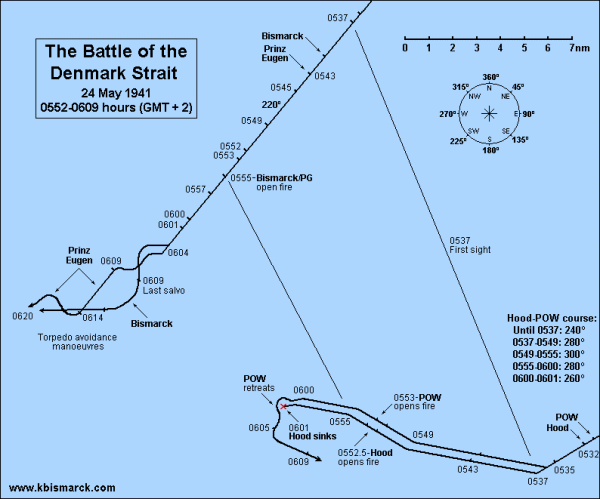
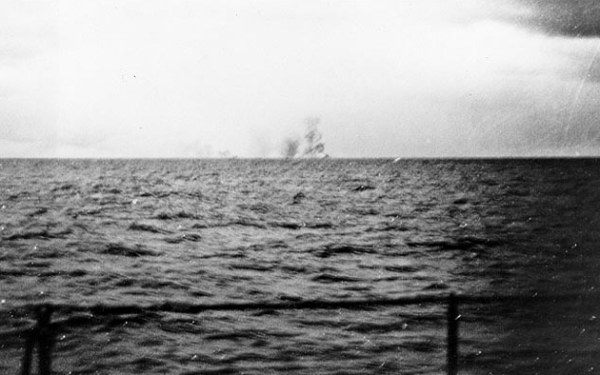
At 0601 hours. The Hood blows up as seen from the Prinz Eugen. It took the Bismarck 40 shells to sink the Hood. Photo: PK-Lagemann.

This is the most well known photo of the battleship Bismarck and one the most famous of World War II as well. It was taken from the Prinz Eugen sometime between 0607 and 0609 hours. By then the Hood had already been sunk and the Bismarck hit by three 14-inch shells. The after turrets "Cäsar" and "Dora" are firing against the Prince of Wales in one of the last salvoes of the battle. Don't be misled, it's daylight but the flash of the guns led to the darkened underexposure of the photo. Photo: PK-Lagemann.
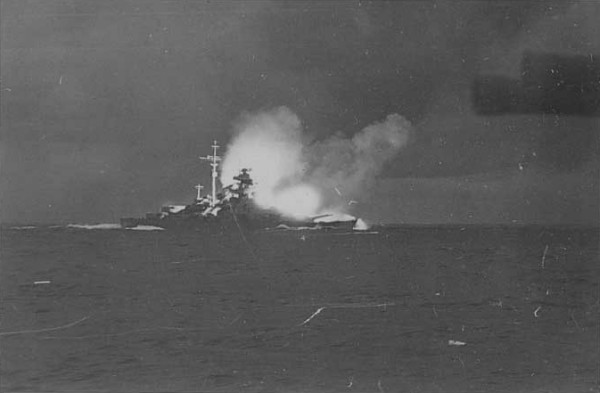
http://www.warship.org/no21987.htm
The Loss of HMS Hood - A Re-Examination
by William J. Jurens
http://www.hmshood.com/history/denmarkstrait/bismarck2.htm
The Pursuit of Bismarck & the Sinking of H.M.S. Hood, Part 2
Written by Frank Allen & Paul Bevand
http://www.kbismarck.com/denmark-strait-battle.html
THE BATTLE OF THE DENMARK STRAIT
By José M. Rico
http://www.hmshood.com/history/denmarkstrait/film.htm
Operation Rheinübung Film
Synopsis by Frank Allen
http://www.hmshood.com/ship/fire_control.htm
Hood’s Fire Control System: an Overview
by William Schleihauf
http://www.hmshood.com/history/denmarkstrait/bonomi_denstrait2.htm
Captain Leach of Prince of Wales, from a distance only 750 meters (4 cables) from the British battlecruiser reported what he saw :
[…] I happened to be looking at the Hood at the moment when a salvo arrived and it appeared to be across the ship somewhere about the mainmast. In that salvo there were, I think, two shots short and one over, but it may have been the other way round. But I formed the impression at the time that something had arrived on board the Hood in a position just before the mainmast and slightly to starboard. It was not a very definite impression that I had, but it was sufficiently definite to make me look at the Hood for a further period. I in fact wondered what the result was going to be, and between one and two seconds after I formed that impression an explosion took place in the Hood which appeared to me to come from very much the same position in the ship. There was a very fierce upward rush of flame the shape of a funnel, rather a thin funnel, and almost instantaneously the ship was enveloped in smoke from one end to the other. […]
Ba-da-bing.

An accurate salvo of l5in. shells from HMS Hood falls a short distance astern of the Prinz Eugen during the opening exchanges of the battle of the Denmark Strait. A minute later the Hood switched targets to engage the Bismarck.
The Bismarck. photographed from Prinz Eugen shortly after the battle of the Denmark Strait. She is down slightly by the bow, a result of flooding caused by a hit from a 14in. shell fired from the battleship Prince of Wales.
The last salvoes of the battle, photographed from Prinz Eugen at around 6.04am. The smoke on the left marks the location of the sinking Hood, while smoke and shell splashes to the right mark the location of Prince of Wales.

An impression of the sinking of the Hood, first published in Time Life magazine. Both bow and stem sections rose up to form a huge V shape before they sank. The Prince of Wales is shown racing past the wreckage.
Larry
Thanks for the photos and info.
One of my favorite movies growing up was “Sink the Bismarck.” Even though it was a cheesy 1961 black & white British movie, made without the aid of computer graphics, and was historically inaccurate in portrayals of the German officers, it still has some of the best movie scenes of naval gunfire combat. There was a scene of Admiral Holland on the bridge of HMS Hood; he looks up as the salvo comes in from Bismarck that will destroy his ship. The look on his face is “uh oh...” It’s a war movie classic.
I've always loved that movie, bad acting and bad facts aside. It's one of the things that made me curious about World War 2-that and the fact that one of my uncles was in the Wehrmacht having fought on the Russian front (and spent 5-1/2 yrs in a Soviet POW camp. He came to the USA, became a citizen and before he passed away left the family several diaries and many photos of his time in Russia. Thanks for the thanks.
Disclaimer: Opinions posted on Free Republic are those of the individual posters and do not necessarily represent the opinion of Free Republic or its management. All materials posted herein are protected by copyright law and the exemption for fair use of copyrighted works.